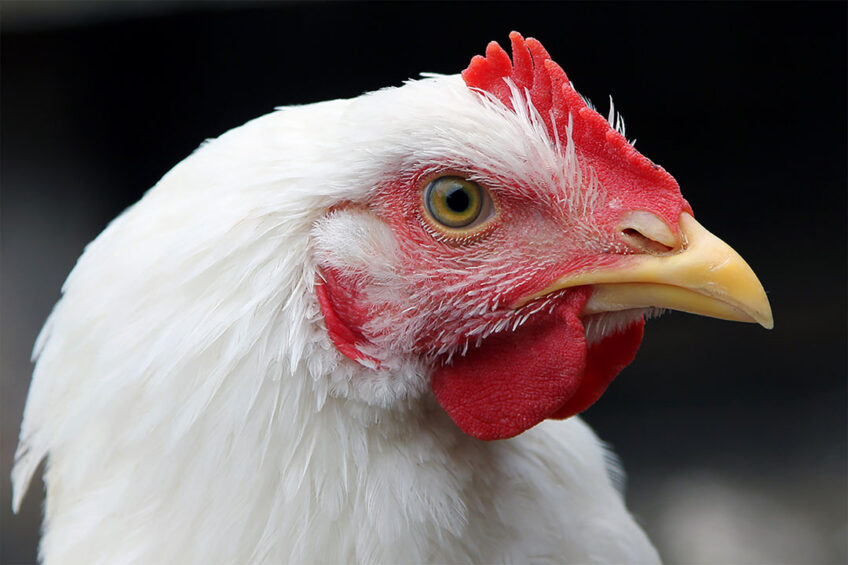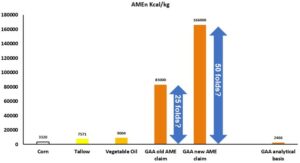GAA does not provide energy saving effects in broilers

Under experimental conditions it has been shown that Guanidino acetic acid (GAA) does not bring any energy saving value into feed. This article will go into depth about the study and the surprising results.
What do we know about Guanidino acetic acid (GAA) and its impact on energy metabolism?
GAA is synthesised in the kidney using glycine and arginine. Then, GAA is transferred from the kidney to the liver where it is methylated to creatine using s-adenosyl methionine (SAM). Carnosine is an important molecule in the energy homeostasis in muscle. GAA is linked to a more efficient energy utilisation in broilers. Although AME content of GAA is around 2466 kcal/kg, GAA is claimed to provide 83000-166000 kcal/kg of AME in broilers (a huge number compared to usual energy sources, see figure 1) which is equal to a reduction of 50-100 kcal/kg of feed by adding 600 grams of GAA per metric ton of feed. Does it hold true? To answer this question, the energy sparing effect of GAA is tested in a trial using 1200 male Ross 308 broilers. In 5 treatments (16 pens each 15 birds), a positive control group with normal energy levels (2960, 3050, and 3150 kcal/kg during starter, grower, and finisher phases, respectively) was compared to 2 diets having either 50 (NC1) or 100 (NC2) kcal less AME. Next 2 diets had either 50 or 100 kcal less AME but supplemented with 600 or 1200 grams of GAA to cover the lack of energy assuming the energy claim of GAA holds true. Broilers were monitored for their performance and slaughter parameters.
Figure 1 – Comparison of energy saving claims of GAA with its real AME content and some common energy sources.

Body weight was not affected or negatively impacted by GAA
Mortality was not affected by any of the treatment groups. BW at day 0, 10, and 24 was also not affected by treatment groups. On day 35, birds of the 600 grams GAA group (-50 kcal + 600 grams GAA) had a lower BW compared to the NC1 (-50 kcal) (P<0.05,>Table 1).
Table 1 – Mean body weight of birds at the end of starter, grower, and finisher phase.

P value shows a difference to control group. Significant difference (sign. diff.) is a multicompanies between treatment groups.
Feed intake was not affected or negatively impacted by GAA
Feed intake was not affected by 50 or 100 kcal/kg reduction in dietary energy (Table 2). In the starter phase, adding 1200 grams GAA per metric ton of a feed containing -100 kcal/kg energy caused a reduction in feed intake. In the finisher phase and during days 0-35, a similar reduction in feed intake happened when birds were fed with a diet lacking 50 kcal/kg energy and supplemented with 600 grams of GAA per metric ton of feed compared to the reference diet (-50 kcal/kg).
Table 2 – Average daily feed intake of birds at the end of starter, grower, and finisher phase.

P value shows a difference to control group. Significant difference (sign. diff.) is a multicompanies between treatment groups.
FCR was not improved by GAA
FCR was not affected by treatments during the grower, finisher, or the whole growth period. During the starter period, 100 kcal reduction of energy caused an increase in FCR, but the other groups stayed irresponsive (Table 3). Slaughter data demonstrated that breast meat weight does not respond to any of the treatment groups (Table 4). Reduction of energy by 50 or 100 kcal did not impact live weight of slaughtered birds or their carcass weight. Adding 600 grams of GAA per metric ton to a diet lacking 50 kcal of energy had a negative impact on live weight and carcass weight of birds compared with the positive control or the diets containing -50 or -100 kcal energy. Leg weight was increased when diet had a lack of energy (-50 kcal) although -100 kcal did not create a similar response. Adding 600 grams of GAA per metric ton to a diet lacking 50 kcal energy reduced the leg weight to a greater extent.
Table 3 – Feed conversion ratio of birds at the end of starter, grower, and finisher phase.

P value shows a difference to control group. Significant difference (sign. diff.) is a multicompanies between treatment groups.
Table 4 – Slaughter data (in kg) of birds at the end of finisher phase.

P value shows a difference to control group. Significant difference (sign. diff.) is a multicompanies between treatment groups.
Any substance can claim 50 kcal energy sparing even sand
Broilers response to different levels of energy is highly dependent on the magnitude of a higher or a lower content of energy. Recent literature has used 125 to 150 kcal / kg feed of lower or higher energy to see a response to energy. Others have gone one step further and used true metabolised energy (TME) and measured the TME of their raw materials to make sure that they will see a response to energy by means of increasing their accuracy. Lower magnitudes (25-50 kcal AME) have often led to a conclusion that birds do not respond to different energy levels. Herein, we also did not observe a clear response of broiler to -50 or -100 kcal AME in their feed as compared to the positive control group except for FCR in the starter phase causing a higher FCR; an effect which was not seen in grower and finisher phase.
GAA is suggested to improve energy homeostasis in muscle tissue because of the data showing extra creatine phosphate and free creatine in muscle tissue. This is often misinterpreted giving GAA a 83000 to 166000 kcal/kg AME value. There is controversy in the literature looking at energy saving effect of GAA. On one hand, a negative impact of GAA on growth parameters is observed specially under deficient or sufficient methionine levels. On the other hand, a positive impact of GAA is concluded when it is added on top of an energy deficient feed. Herein, addition of GAA to an energy deficient diet had no positive impact on performance parameters.
Take home message
Measuring impact of energy on broiler’s performance parameters is a factor of the magnitude of the changes in dietary energy. A reduction or increase in feed energy levels less than 125-150 kcal AME/kg is a challenge to be measured in broilers even under experimental conditions. In this study, GAA did not bring any energy saving value into feed. Thus, it is not recommended to consider an extra energy matrix value for GAA more than the AME content of GAA (~2466 kcal/kg).
References are available on request
Author:
Dr. Behnam Saremi, Director of Technical Center, CJ Europe GmbH
Join 31,000+ subscribers
Subscribe to our newsletter to stay updated about all the need-to-know content in the poultry sector, three times a week. Beheer
Beheer

 WP Admin
WP Admin  Bewerk bericht
Bewerk bericht